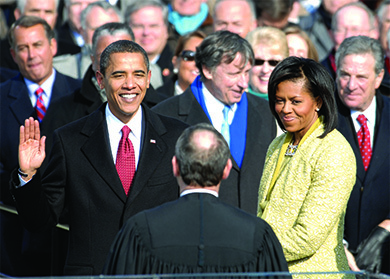| << Chapter < Page | Chapter >> Page > |
Senator Obama, too, was criticized for his lack of experience with foreign policy, a deficit he remedied by choosing experienced politician Joseph Biden as his running mate. Unlike his Republican opponent, however, Obama offered promises of hope and change. By sending out voter reminders on Twitter and connecting with supporters on Facebook, he was able to harness social media and take advantage of grassroots enthusiasm for his candidacy. His youthful vigor drew independents and first-time voters, and he won 95 percent of the African American vote and 44 percent of the white vote ( [link] ).

Barack Obamas campaign seemed to come out of nowhere to overcome the widely supported frontrunner Hillary Clinton in the Democratic primaries. Having won the nomination, Obama shot to the top with an exuberant base of youthful supporters who were encouraged and inspired by his appeal to hope and change. Behind the scenes, the Obama campaign was employing technological innovations and advances in social media to both inform and organize its base.
The Obama campaign realized early that the key to political success in the twenty-first century was to energize young voters by reaching them where they were: online. The organizing potential of platforms like Facebook, YouTube, and Twitter had never before been tappedand they were free. The results were groundbreaking. Using these social media platforms, the Obama campaign became an organizing and fundraising machine of epic proportions. During his almost two-year-long campaign, Obama accepted 6.5 million donations, totaling $500 million. The vast majority of online donations were less than $100. This accomplishment stunned the political establishment, and they have been quick to adapt. Since 2008, nearly every political campaign has followed in Obamas footsteps, effecting a revolution in campaigning in the United States.
Barack Obama had been elected on a platform of healthcare reform and a wave of frustration over the sinking economy. As he entered office in 2009, he set out to deal with both. Taking charge of the TARP program instituted under George W. Bush to stabilize the countrys financial institutions, Obama oversaw the distribution of some $7.77 trillion designed to help shore up the nations banking system. Recognizing that the economic downturn also threatened major auto manufacturers in the United States, he sought and received congressional authorization for $80 billion to help Chrysler and General Motors. The action was controversial, and some characterized it as a government takeover of industry. The money did, however, help the automakers earn a profit by 2011, reversing the trend of consistent losses that had hurt the industry since 2004. It also helped prevent layoffs and wage cuts. By 2013, the automakers had repaid over $50 billion of bailout funds. Finally, through the 2009 American Recovery and Reinvestment Act (ARRA), the Obama administration pumped almost $800 billion into the economy to stimulate economic growth and job creation.

Notification Switch
Would you like to follow the 'U.s. history' conversation and receive update notifications?